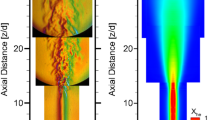Abstract
We present velocity power spectra computed by the so-called direct method from burst-type laser Doppler anemometer (LDA) data, both measured in a turbulent round jet and generated in a computer. Using today’s powerful computers, we have been able to study more properties of the computed spectra than was previously possible, and we noted some unexpected features of the spectra that we now attribute to the unavoidable influence of a finite measurement volume (MV). The most prominent effect, which initially triggered these studies, was the appearance of damped oscillations in the higher frequency range, starting around the cutoff frequency due to the finite size of the MV. Using computer-generated data mimicking the LDA data, these effects have previously been shown to appear due to the effect of dead time, i.e., the finite time during which the system is not able to acquire new measurements. These dead times can be traced back to the fact that the burst-mode LDA cannot measure more than one signal burst at a time. Since the dead time is approximately equal to the residence time for a particle traversing a measurement volume, we are dealing with widely varying dead times, which, however, are assumed to be measured for each data point. In addition, the detector and processor used in the current study introduce a certain amount of fixed processing and data transfer times, which further contribute to the distortion of the computed spectrum. However, we show an excellent agreement between a measured spectrum and our modeled LDA data, thereby confirming the validity of our model for the LDA burst processor.









Similar content being viewed by others
Notes
Time between events is usually described by exponential distributions. However, the dead times may alter the shape of the distribution. The Weibull distribution was employed in this particular case since it provided a sensible fit to the measured residence time distribution. Note that the LDA dead time model presented in the present work does not depend on the type of distribution, but can be used with any distribution providing a good fit to measured data.
References
Albrecht HE, Borys M, Damaschke N, Tropea C (2003) Laser Doppler and phase Doppler measurement techniques. Springer, Berlin, Heidelberg
Benedict LH, Nobach H, Tropea C (2000) Estimation of turbulent velocity spectra from laser Doppler data. Meas Sci Technol 11:1089–1104
Buchhave P (1979) Errors and correction methods in turbulence measurements with the LDA. Ph.D. Dissertation. State University of New York at Buffalo
Buchhave P, George WK, Lumley JL (1979) The measurement of turbulence with the laser-Doppler anemometer. Annu Rev Fluid Mech 11:443–504
Buchhave P, Velte CM, George WK (2014) The effect of dead time on randomly sampled power spectral estimates. Exp Fluids 55:1680. doi:10.1007/s00348-014-1680-1
Frontera F, Fuligni F (1978) The effect of dead time on the power spectral density estimates of discrete time series. Nucl Instrum Method 157:557–561
Gamard S, Jung D, George WK (2004) Downstream evolution of the most energetic modes in a turbulent axisymmetric jet at high Reynolds number. Part 2. The far-field region. J Fluid Mech 514:205–230
Gaster M, Roberts JB (1975) Spectral analysis of randomly sampled signals. J Inst Math Appl 15:195–216
Gaster M, Roberts JB (1977) The spectral analysis of randomly sampled records by a direct transform. Proc R Soc A 354:27–58
Gaster M (2013) Private communication
George WK, Beuther PD, Lumley JL (1978) Processing of random signals. Proceedings of the dynamic flow conference, Skovlunde, Denmark, pp 757–800
Jung D, Gamard S, George WK (2004) Downstream evolution of the most energetic modes in a turbulent axisymmetric jet at high Reynolds number. Part 1. The near-field region. J Fluid Mech 514:173–204
Velte CM (2009) Characterization of vortex generator induced flow. Ph.D. Dissertation. Technical University of Denmark
Velte CM, George WK, Buchhave P (2014) Estimation of burst-mode LDA power spectra. Exp Fluids 55:1674. doi:10.1007/s00348-014-1674-z
Wänström M, George WK, Meyer KE (2012) Streamwise and radial decomposition of a turbulent axisymmetric jet. Progress in turbulence and wind energy IV, Springer proceedings in physics Volume 141, proceedings of the iTi conference in turbulence 2010, pp 147–150. doi:10.1007/978-3-642-28968-2_31
Zhang W, Jahoda K, Swank JH, Morgan EH, Giles AB (1995) Dead-time modifications to fast Fourier transform power spectra. Astroph J 449:930–935
Acknowledgments
The authors gratefully acknowledge the support of the Reinholdt W. Jorck og Hustrus Fond, Journal No. 13-J9-0026 and Fabriksejer, Civilingeniør Louis Dreyer Myhrwold og hustru Janne Myhrwolds Fond, Journal No. 13-M7-0039.
Author information
Authors and Affiliations
Corresponding author
Rights and permissions
About this article
Cite this article
Velte, C.M., Buchhave, P. & George, W.K. Dead time effects in laser Doppler anemometry measurements. Exp Fluids 55, 1836 (2014). https://doi.org/10.1007/s00348-014-1836-z
Received:
Revised:
Accepted:
Published:
DOI: https://doi.org/10.1007/s00348-014-1836-z




